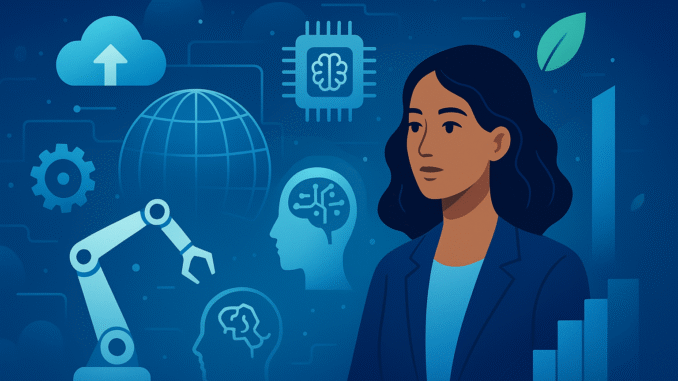
Emerging Tech Trends 2025: Innovations Shaping the Future of Our Digital World
Technology is evolving at a pace we’ve never seen before. Every year brings fresh innovations that redefine how we live, work, and connect with the world. As we step into 2025, the digital landscape is transforming rapidly, powered by artificial intelligence, automation, extended reality, and sustainable innovation. These new trends are not only shaping industries but also changing our daily lives in profound ways.
In this article, we’ll explore the most impactful emerging tech trends of 2025 and how they’re revolutionizing our future—from smarter cities and personalized AI to green tech and next-gen computing.
1. Artificial Intelligence (AI) Becomes More Human-Centric
AI has been the most transformative technology of the past decade, and in 2025, it’s becoming more human-like than ever. The new wave of human-centric AI focuses on understanding emotions, ethics, and context rather than just data and logic.
Key Advancements in AI 2025:
- Emotion AI (Affective Computing): Machines can now detect human emotions through voice, facial expressions, and behavior. This innovation is reshaping industries like healthcare, marketing, and customer service.
- Generative AI Expansion: After the success of chatbots and image generators, generative AI tools are now integrated into workplaces to create presentations, design prototypes, and even write code.
- Personal AI Assistants: AI companions are evolving to become digital life managers—handling emails, finances, and wellness suggestions with a personalized touch.
By 2025, AI is not replacing humans but enhancing human capability—helping people make smarter decisions, save time, and focus on creativity.
2. Quantum Computing Breaks Through
Quantum computing has long been seen as the next frontier of technology, and 2025 marks a turning point. With advancements from major tech players, quantum processors are finally reaching levels where they can solve problems beyond the reach of classical computers.
Why Quantum Matters:
Quantum computers can process data exponentially faster by working with quantum bits (qubits) instead of binary bits. This opens possibilities in:
- Drug discovery and medical research by simulating complex molecular interactions.
- Financial modeling for predicting market shifts with unprecedented accuracy.
- Cybersecurity through new encryption methods that even supercomputers can’t crack.
Quantum computing is still in its early commercial stage, but 2025 is the year it starts moving from lab to reality, promising breakthroughs across science and industry.
3. Extended Reality (XR): The Future of Digital Interaction
The boundaries between the digital and physical worlds are blurring thanks to Extended Reality (XR)—a combination of virtual reality (VR), augmented reality (AR), and mixed reality (MR).
In 2025, XR is going mainstream. Devices are becoming more affordable, lighter, and more immersive, changing how people learn, shop, and socialize.
How XR Is Transforming Industries:
- Education: Students can explore ancient civilizations or conduct virtual lab experiments from home.
- Retail: Virtual try-ons and 3D product previews allow consumers to experience items before buying.
- Work: Remote collaboration now happens in virtual meeting rooms, making hybrid work more engaging and productive.
Tech giants like Apple, Meta, and Microsoft are investing heavily in spatial computing, turning XR into a central part of the digital ecosystem.
4. The Rise of Smart Cities
Urban areas are becoming increasingly intelligent thanks to smart city technologies that leverage IoT (Internet of Things), big data, and AI. These cities use digital systems to optimize resources, improve public safety, and enhance quality of life.
Smart City Innovations in 2025:
- Sustainable Infrastructure: Smart grids, solar panels, and AI-controlled energy systems reduce waste and emissions.
- Connected Mobility: Autonomous vehicles and AI-driven traffic management are cutting congestion and pollution.
- Public Services: Smart sensors monitor air quality, waste collection, and even street lighting in real time.
By 2025, cities like Singapore, Dubai, and Amsterdam are leading examples of tech-driven urban efficiency, inspiring others to follow suit.
5. Green Tech and Sustainable Innovation
As climate change continues to be a pressing issue, 2025 is witnessing a surge in green technology—innovations designed to promote sustainability and reduce carbon footprints.
Key Green Tech Trends:
- AI in Climate Modeling: Machine learning predicts environmental changes and helps governments take proactive measures.
- Renewable Energy Storage: New battery technologies make solar and wind energy more reliable.
- Eco-Friendly Manufacturing: 3D printing and biodegradable materials are transforming production methods.
Sustainability is now embedded in every stage of product design and corporate strategy. The companies that embrace clean technology today are leading the markets of tomorrow.
6. The 5G and 6G Evolution
5G networks have already improved internet speeds and connectivity, but 2025 is seeing the early rollout of 6G research and testing. With even higher bandwidth and ultra-low latency, 6G will support technologies that require massive data transmission in real time.
Impact of 5G and 6G:
- Smarter IoT Devices: Billions of connected sensors and devices communicating seamlessly.
- Enhanced Remote Work and Education: Video quality, speed, and reliability improve dramatically.
- Holographic Communication: Real-time hologram meetings could soon become a reality.
The connectivity revolution ensures that emerging technologies—from self-driving cars to AI-powered factories—can operate at their full potential.
7. The Evolution of Cybersecurity: AI vs. AI
As digital transformation accelerates, so does cybercrime. By 2025, cybersecurity is no longer optional—it’s essential. Interestingly, AI is both the attacker and the defender in this evolving battle.
Modern Cybersecurity Measures:
- AI-Powered Threat Detection: Algorithms predict and neutralize attacks before they occur.
- Zero-Trust Architecture: Every access request is verified, even within private networks.
- Biometric Authentication: Facial recognition, voice ID, and fingerprint scans strengthen security across devices.
Cybersecurity is now deeply integrated into the design phase of products and systems—a shift from reactive to proactive digital protection.
8. Robotics and Automation in Everyday Life
Robots are no longer confined to factories. In 2025, intelligent automation is transforming industries like healthcare, logistics, and agriculture.
Examples of Real-World Automation:
- Healthcare Robots: Surgical robots and patient-care assistants improve precision and reduce workloads.
- Delivery Drones and Self-Driving Cars: Faster, safer, and more efficient transport solutions.
- Agricultural Automation: Drones and sensors monitor crops, soil, and weather for better yields.
Automation doesn’t just replace labor—it creates opportunities for humans to focus on creativity, strategy, and problem-solving.
9. The Growth of Edge Computing
While cloud computing remains essential, edge computing—processing data closer to where it’s generated—is becoming vital in 2025. This reduces latency and bandwidth use, allowing faster responses in applications like autonomous vehicles and smart devices.
Edge computing is especially critical for:
- IoT networks
- Healthcare monitoring
- Industrial automation
As devices become smarter and more connected, edge computing ensures they remain fast, secure, and efficient.
10. Biotechnology and Human Enhancement
Technology and biology are merging in exciting ways. In 2025, biotechnology innovations are transforming healthcare, agriculture, and even human potential.
Major Developments:
- CRISPR and Gene Editing: Precision treatments for genetic diseases.
- Bioengineered Materials: Lab-grown meat and eco-friendly fabrics.
- Wearable Health Tech: Smart implants and biosensors providing real-time body data.
The future promises a world where humans and technology evolve together—creating healthier, longer, and more sustainable lives.
Conclusion: Building a Smarter, Sustainable Future
The emerging tech trends of 2025 are more than just tools—they’re the foundation of a smarter, more connected, and more sustainable world. From AI-powered systems to quantum breakthroughs and green innovations, technology is no longer just about convenience—it’s about improving life on a global scale.
As we move forward, one thing is certain: the pace of innovation will only accelerate. Those who embrace these changes—businesses, governments, and individuals—will be best positioned to thrive in the digital future that’s already unfolding before our eyes.

